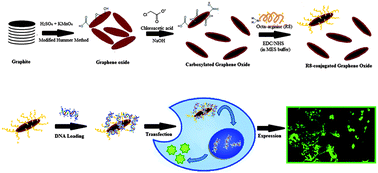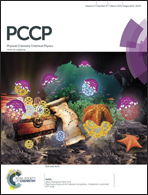Synthesis and characterization of an octaarginine functionalized graphene oxide nano-carrier for gene delivery applications
Abstract
The success of gene therapy is largely dependent on the development of a gene carrier. Recently cell-penetrating peptides (CPPs) have been employed for enhancing the gene and drug delivery efficacy of nano-particles. The feasibility of octaarginine (R8) functionalized graphene oxide (GO) as a novel nano-carrier for gene delivery is investigated. A DNA plasmid expressing enhanced green fluorescent protein (pEGFP) is used as a model gene to study the R8–GO transfection ability into mammalian cells. R8 peptide is conjugated in different ratios (0.1–1.5 μmol per mg of GO) to carboxylated graphene oxide by a two step amidation process. The process of peptide conjugation is analyzed by Fourier transform infrared (FTIR), atomic force microscopy (AFM), UV-vis spectroscopy and X-ray diffraction (XRD). In order to obtain the highest transfection of pEGFP into the cells, the amount of peptide bound to GO is optimized which is evidenced by dynamic light scattering (DLS), zeta potential, TNBS and gel retardation assays. The cytotoxicity of R8-functionalized GO is also tested by MTT assay. The results confirm the successful attachment of R8 peptide to GO. The AFM and XRD results show a significant increase in the thickness of nano graphene oxide sheets (NGOS) from 0.8 to 2–7 nm as well as an increase in the GO interlying space after the R8-functionalization process. A reduction in nano-carrier stability in both aqueous solution and cell culture media is observed when the amount of peptide is increased to more than 1 μmol mg−1. Gel electrophoresis analysis shows the highest DNA loading on the peptide functionalized GO at the ratios of 0.5 and 1 μmol mg−1. As a result, the conjugated peptide sample with a peptide molar ratio of 1 μmol per mg of GO shows the highest conjugational efficiency and EGFP gene expression along with improved dispersibility and biocompatibility. Overall, the findings reveal the importance of peptide density on the surface of NGOS in order to obtain the most efficient cell transfection. It is concluded that the R8-conjugated GO could be a promising nano-carrier for gene delivery with relevance in biotechnology therapeutics and clinical applications.


 Please wait while we load your content...
Please wait while we load your content...